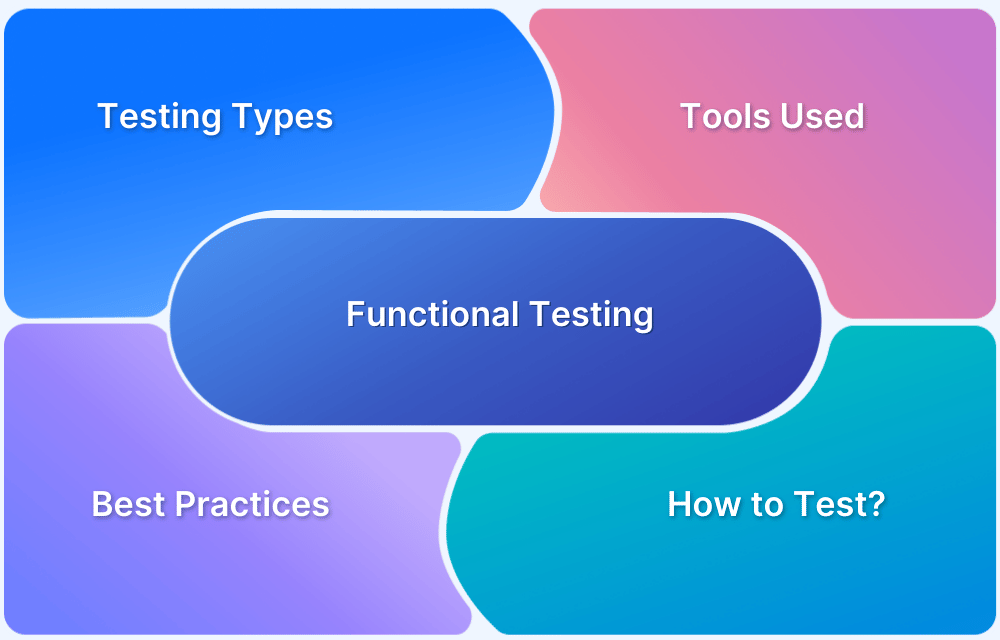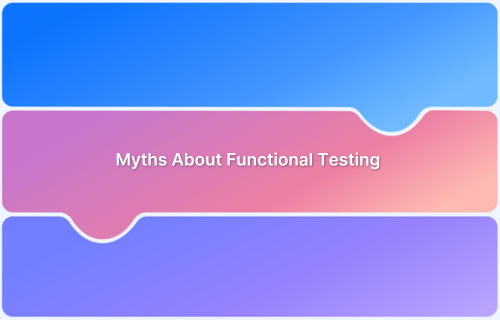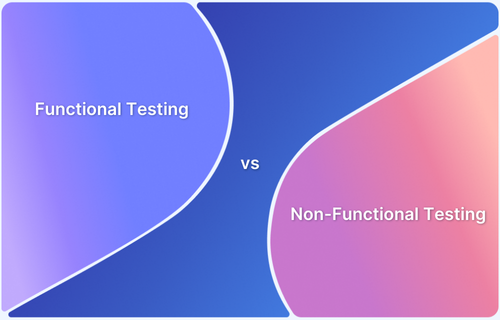As software systems grow in complexity and release cycles shorten, validating application functionality at scale becomes increasingly challenging. Automated functional testing addresses this need by executing predefined test cases to verify that applications behave as expected under various conditions.
Overview
Automated functional testing is a software testing method that uses scripts and tools to verify that application features work as intended. It simulates user interactions and checks system responses against expected outcomes.
Purpose
Automated functional testing ensures that application features work correctly across updates. It accelerates testing cycles, supports continuous integration, and improves software reliability.
Benefits
- Faster and repeatable test execution
- Early detection of functional regressions
- Improved test accuracy by eliminating manual errors
- Supports continuous integration and delivery (CI/CD) pipelines
Popular Tools & Frameworks
- BrowserStack Automate: Cloud-based platform for cross-browser testing on real devices, integrates with multiple test frameworks
- Cypress: Fast, developer-friendly framework for modern web apps
- Selenium: Widely adopted, supports multiple languages and browsers
- Puppeteer: Node.js library for testing Chrome and Chromium
- WebdriverIO: Versatile automation framework with WebDriver and DevTools support
- NightwatchJS: All-in-one Node.js framework with built-in test runner and assertions
This article covers what automated functional testing is, which tests to automate, and the best tools and frameworks.
What is Automated Functional Testing?
Functional testing is a quality assurance process that verifies whether software features perform according to defined requirements. It focuses on testing user-facing functions, such as form submissions, logins, and navigation, without considering the internal code structure.
Automated functional testing extends this process by using scripts and tools to execute these checks automatically. Instead of running tests manually, teams can validate functionality across multiple browsers, devices, and user scenarios at scale. This improves test speed, accuracy, and coverage while supporting continuous development workflows.
With BrowserStack, teams can seamlessly run automated functional tests on real browsers and devices in the cloud, ensuring consistent performance across all environments without the need for complex infrastructure setup.
Difference between Functional and Non-Functional Automated Testing
While both functional and non-functional testing are essential to software quality, they serve different purposes. The table below highlights the key differences between the two.
| Aspect | Functional Testing | Non-Functional Testing |
|---|---|---|
| Objective | Verifies that the software performs expected functions | Evaluates performance, reliability, usability, and other attributes |
| Examples of Tests | Smoke Testing, Sanity Testing, Regression Testing, Unit Testing | Load testing, stress testing, scalability testing |
| User Involvement | Simulates real user interactions | Simulates system behavior under load or constraints |
| Automation Priority | Often automated for regression and CI/CD | Frequently automated for performance benchmarking |
To explore the differences between functional and non-functional testing in detail, refer to Functional vs Non-Functional Testing.
Which Parts of the Functional Test Should be Automated?
Deciding which parts of functional testing to automate requires careful consideration of several factors. While automation offers significant benefits, not all tests should be automated. Here are some guidelines to help you decide:
- Repetitiveness: Automate tests that are frequently repeated, such as regression tests, smoke tests, or those covering common user flows. These tests benefit from automation by reducing the manual effort needed for every release cycle.
- Critical Business Processes: Focus on automating key user journeys and core business functionalities. These include registration, login, checkout, and payment processes, where errors could significantly impact the business.
- Complexity of Test Cases: Automate test cases that involve complex interactions or combinations of inputs, where manual execution would be time-consuming and prone to human errors.
- Cross-Browser or Cross-Device Testing: When you need to validate that your application works consistently across different browsers and devices, automation can significantly reduce testing time and increase coverage.
- Long-Running Tests: Some tests, such as load testing or performance testing, are too lengthy or resource-intensive for manual execution. Automating these can help achieve better efficiency and scalability.
How to Design Automated Functional Tests?
Designing effective automated functional tests requires thoughtful planning and alignment with business goals. Here’s a step-by-step approach:
- Understand Functional Requirements: Review business goals, user stories, and application behavior. Identify the most critical workflows that users rely on, such as login, checkout, or data submission. Prioritize these flows based on usage frequency and their importance to the application’s success.
- Define Test Scenarios and Test Cases: Break down each workflow into specific, testable actions. Define clear input conditions and expected outcomes. Each test case should verify a single functionality to keep tests focused and easy to debug.
- Choose the Right Automation Framework: Select a framework that fits your application architecture and your team’s technical skillset. Consider factors like ease of integration with CI/CD pipelines, community support, and compatibility with your existing tools.
- Prepare Test Data and Environment: Use consistent, reusable test data and ensure the test environment mirrors production as closely as possible. Automate setup tasks such as creating test users or resetting databases to maintain reliability across test runs.
- Write Scalable and Maintainable Tests: Use modular code, clear naming conventions, and reusable functions to simplify maintenance. Avoid hard-coded waits; use smart waits that respond to the application’s state. Structure your test suite so that tests can run independently and in parallel.
- Integrate with CI/CD Workflows: Connect your test suite with your CI/CD pipeline so that tests run automatically with every code change. This ensures that regressions are caught early and functionality is continuously validated across development cycles.
Advantages of Functional Testing
The advantages of Functional Testing are as follows:
- End-user satisfaction: Functional testing ensures that a given product meets the actual requirements and the end-user will be satisfied with the product.
- High-quality product: It ensures the high quality of the product by replicating the actual product and testing it against the actual requirements.
- Bug-free product: It also ensures that the product has no bugs and is working as per the customers’ requirements.
- Better Security: Functional testing also checks for different security aspects of the software. It ensures the product is risk-free and can be used for storing users’ sensitive data.
Different Types of Functional Testing
Some of the different types of functional testing are discussed below:
Unit Testing
Unit testing checks that each of the smallest components that can function independently operates as expected. In unit testing, developers test the code of each of these Units and identify any errors in the code. This helps in identifying possible bugs right at the beginning of a test cycle, saving time and resources. Each unit of code is thoroughly tested alone before moving to another unit.
Read More: Best Practices for Unit Testing
Sanity Testing
Sanity testing is done to ensure that all the major and vital functionalities of the application or system are working correctly. Sanity test is generally done after a smoke test.
Smoke Testing
Smoke testing is performed after each build is released to test the build’s stability. It is also called build verification testing.
Regression Testing
Regression testing ensures that the addition of new code enhancements and bug fixing will not break the existing functionality or cause any instability and the application will work according to the required specifications. Regression tests are run for each release to check the effect of a new feature on existing functions.
Read More: How to run Regression Testing in Agile Teams
Integration Testing
When the system is build-up of multiple functional modules, it is essential to check how they work coherently. It is because sometimes they might individually work perfectly but when grouped together to achieve an end-to-end scenario it might not deliver as expected. Validation of such scenarios is known as Integration testing. By performing end-to-end testing of the application, you can test how well the modules integrate with each other.
Read More: How to perform End to End Testing in Angular
Different Tools used for Automating Functional Testing
Some popular tools for automated functional testing include:
- BrowserStack Automate enables functional testing on real browsers and devices using frameworks like Selenium, Cypress, and Playwright. It supports seamless CI/CD integration, parallel test execution, and interactive debugging with video logs and session replays, helping teams test faster and more reliably across environments.
- Cypress is a JavaScript-based testing framework. It enables teams to create test automation scripts. It is framework agnostic, which means there is no need to rewrite new tests if the application is moved to a different framework.
- Selenium is one of the most popular open-source automated testing suites for web applications. Selenium is composed of several components with each performing a specific role in aiding the test automation. Selenium supports multiple test system environments such as Windows, Mac, Linux, and browsers such as Chrome, Firefox, IE, etc.
- Puppeteer is an open-source node js library used for automating and streamlining the frontend development and testing respectively. Puppeteer contains APIs to interact and manage the Chrome browser in headless mode. However, it can also be used for non-headless execution on browsers like Chrome, Firefox, etc.
- WebdriverIO is an automation framework built to automate modern web and mobile applications. It simplifies the interaction with the app and provides a set of plugins that help to create a scalable, robust, and stable test suite. WebdriverIO leverages the power of the WebDriver protocol that is developed and supported by all browsers and guarantees a true cross-browser testing experience.
- NightwatchJS is an integrated, easy-to-use end-to-end testing solution for web applications written in NodeJS. It provides a built-in command-line test runner which runs the tests either sequentially or in parallel, with retries and implicit waits. It also works with BrowserStack out of the box.
How to perform Automated Functional Testing?
Automated functional testing involves using scripts and tools to verify that an application works as expected from the end-user’s perspective. The process typically follows these steps:
- Identify Target Functionality: Start by defining which application features need testing. This includes core functions, boundary conditions, error handling, and user messages.
- Prepare Input Data: Create structured input data based on the test scenarios. Ensure it aligns with the functional requirements and covers both valid and invalid conditions.
- Define Expected Output: Determine the expected results for each input to validate whether the functionality behaves as intended.
- Develop and Run Test Scripts: Write automated test scripts using tools like Selenium, Cypress, or Playwright. Execute them on real browsers and devices, ideally through a cloud platform like BrowserStack Automate.
- Compare Actual vs Expected Results: Analyze the output from the test runs and compare it with the expected results. Log discrepancies and refine scripts or application logic as needed.
Run Automated Functional Tests
Best Practices for Automated Functional Testing
Follow these best practices to ensure your automated functional tests are reliable, maintainable, and deliver consistent value throughout the development lifecycle.
- Use well-planned test case execution: Test execution is the process of testing specific workflows in the app. It is crucial to functional testing. By planning test-case execution rigorously, one can ensure that the test case covers all the functionality.
- Write reusable test cases: Test cases should be written in such a way that they can be reused. It helps to save time and can reduce complexity.
Read More: Fundamentals of Writing Good Test Cases
- Embrace automation: While all tests cannot be automated, there will certainly be some opportunities, which can make it easier to run tests more often and save time in the software development process.
- Document everything: It is a critical aspect of testing. Documenting helps while working in a team as it makes it easier for other teammates to understand what bugs have been identified and how to fix them.
Read More: Benefits of Automation Testing
Conclusion
While Functional testing is the backbone of the testing process in the software development life cycle, it is essential to maintain a high level of accuracy for the tests. This is possible with the use of Real Device Cloud as opposed to Emulators and Simulators so that you can test your application under real user conditions. It allows you to identify the bottlenecks in the user experience by considering various real factors like network conditions, geolocation, etc. for a more realistic testing experience.
Teams can leverage cloud-based platforms like BrowserStack that offer a Cloud Selenium Grid of 3500+ real browsers and devices. It empowers teams to run concurrent manual and automated functional tests on desired real device-browser combinations online, using frameworks such as Selenium, Cypress, Playwright, Puppeteer, NightwatchJS, Protractor, etc. You can also integrate these functional tests with their CI/CD pipelines such as Jenkins, CircleCI, Travis CI, etc for streamlined software development using DevOps.
It also helps accelerate testing time with parallel testing, and get results faster without compromising on accuracy.






